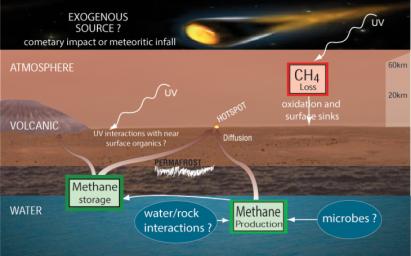
|
Potential Sources and Sinks of Methane on Mars
- Click the image above for a larger view
- Full-Res JPEG (840 x 524) (60.6 kB)
- Full-Res TIFF (840 x 524) (1.3 MB)
Caption:
If the atmosphere of Mars contains methane, various possibilities have been proposed for where the methane could come from and how it could disappear.
Potential non-biological sources for methane on Mars include comets, degradation of interplanetary dust particles by ultraviolet light, and interaction between water and rock. A potential biological source would be microbes, if microbes have ever lived on Mars. Potential sinks for removing methane from the atmosphere are photochemistry in the atmosphere and loss of methane to the surface.
Background Info:
Researchers are using Curiosity's 10 instruments to investigate whether areas in Gale Crater ever offered environmental conditions favorable for microbial life. JPL, a division of the California Institute of Technology in Pasadena, manages the project for NASA's Science Mission Directorate, Washington, and built Curiosity. The SAM instrument was developed at Goddard with instrument contributions from Goddard, JPL and the University of Paris in France.
For more information about Curiosity and its mission, visit: http://www.nasa.gov/msl and http://mars.jpl.nasa.gov/msl .
Cataloging Keywords:
| Name | Value | Additional Values |
|---|---|---|
| Target | Mars | |
| System | ||
| Target Type | Planet | |
| Mission | Mars Science Laboratory (MSL) | |
| Instrument Host | Curiosity Rover | |
| Host Type | Rover | |
| Instrument | Sample Analysis at Mars (SAM) | |
| Detector | ||
| Extra Keywords | Atmosphere, Color, Comet, Crater, Dust, Methane, Ultraviolet, Water | |
| Acquisition Date | ||
| Release Date | 2012-11-02 | |
| Date in Caption | ||
| Image Credit | NASA/JPL-Caltech, SAM/GSFC | |
| Source | photojournal.jpl.nasa.gov/catalog/PIA16461 | |
| Identifier | PIA16461 | |
